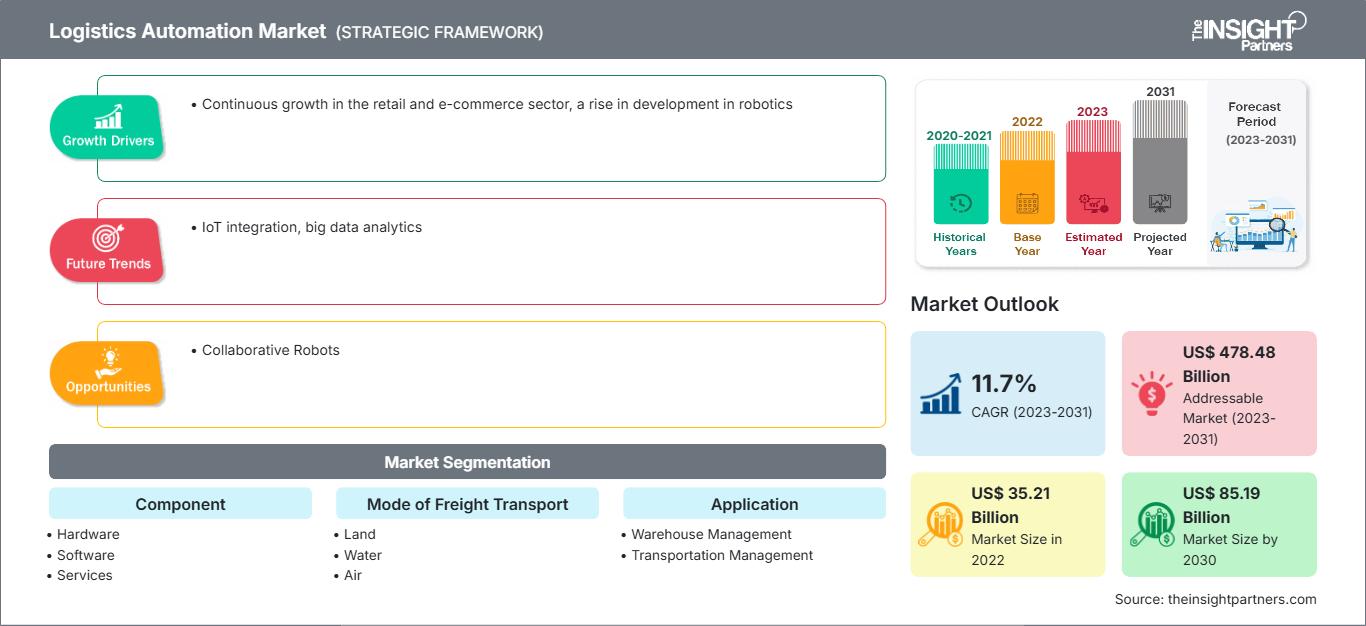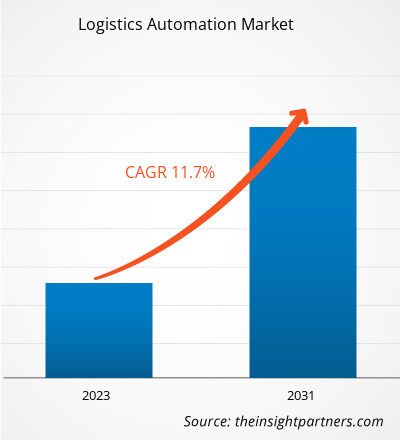物流自動化市場規模は、2022年の352億1,000万米ドルから2030年には851億9,000万米ドルに達すると予測されています。市場は2022年から2030年にかけて11.7%のCAGRを記録すると予想されています。IoTの統合とビッグデータ分析は、引き続き市場の重要なトレンドになると見込まれます。
物流自動化市場分析
消費者の期待が高まるにつれて、市場プレーヤーは倉庫のITと運用機能への投資に注力しています。テクノロジー企業が仕分けから配置まですべてを行うため、世界的に接続技術の開発が進んでいます。彼らは最新のサプライチェーン技術とモノのインターネット(IoT)を活用しています。スマート倉庫は、サプライチェーンプロセスの効率と速度を向上させるハブとして機能します。作業員のウェアラブルからセンサーやスマート機器まで、インターネット対応のデバイスとテクノロジーは、物流管理を大きく変えることができます。倉庫管理および輸送管理では、サプライチェーン全体にわたる商品の保管と移動を自動化する物流自動化ロボットの導入が積極的に進んでいます。物流自動化ロボットは、倉庫や保管施設全体に統合され、商品の整理と輸送を行います。これらのロボットは、手作業に比べて稼働率を向上させるため、業界の生産性と収益性の向上につながります。物流ロボットの主な用途は、保管施設や倉庫に配備され、商品を輸送する移動式無人搬送車(AGV)です。AGVは、倉庫内の様々なパレットに積まれた商品を出荷および保管するために、事前に設定された経路で動作します。AGVは、物流コスト全体の削減とサプライチェーンの効率的な合理化に役立ちます。したがって、倉庫におけるロボットの利用増加は、今後数年間の物流自動化市場予測に大きな影響を与える可能性があります。
物流自動化市場の概要
物流自動化市場では、近年、倉庫やヤードなどの厳密に管理された環境での自動運転車の導入が増加しており、物流事業における自動運転車の重要性が高まっています。しかし、高速道路や市街地などの公共の共有スペースへの自動運転車の導入は、物流業務の最適化と安全性の向上に向けた、業界にとって次なる大きな一歩となる可能性があります。AI技術の発展、そしてセンサーや視覚技術の開発への多額の投資の増加は、自動運転車の発展を後押しする可能性があります。自動運転車とドローンは、自動物流システムの重要な構成要素です。例えば、GoogleとTeslaは、無人運転車の技術において大きな進歩を遂げてきました。自動運転は、レーダー技術とコンピューターパワーの飛躍的な進歩により、過去20年間でSFの世界から非常に現実的な可能性へと進化しました。ポータブル技術の進歩により、超軽量ハードウェアが自己改善アルゴリズムに基づいて意思決定を行えるようになったため、エンジニアは自動運転車において人間の意思決定を模倣できる可能性が高まっています。
要件に合わせてレポートをカスタマイズ
レポートの一部、国レベルの分析、Excelデータパックなどを含め、スタートアップ&大学向けに特別オファーや割引もご利用いただけます(無償)
物流自動化市場: 戦略的洞察

-
このレポートの主要な市場動向を入手してください。この無料サンプルには、市場動向から見積もりや予測に至るまでのデータ分析が含まれます。
物流自動化市場の推進要因と機会
小売・Eコマース分野の継続的な成長が市場を後押し
物流自動化は、在庫、追跡、梱包、倉庫保管、配送といった課題を管理するためのEコマースの重要な要素の一つです。小売・Eコマース業界では、企業はタイムリーな配送と返品ポリシーの確保に責任を負っています。商品や製品の交換が必要な場合、企業はリバースロジスティクスの全業務を処理しなければなりません。小売・Eコマース業界では、物流自動化プロバイダーが、高度な技術、拡張性、柔軟性、そして効率性を提供します。さらに、Eコマース分野は成長を続けています。例えば、インドでは2020年以降、オンラインショッピングをする人が1億2500万人増加しており、2025年までにさらに8000万人に達すると予想されています。
小売業やeコマース企業向けに物流自動化ソフトウェア企業が提供する物流要件とサービスには、倉庫管理、サプライチェーン管理、統合サービス、注文処理などがあります。企業が物流自動化サービスプロバイダーを通じて物流要件をアウトソーシングすれば、eコマースに関連するいくつかのメリットを実現できます。これにより、小売業やeコマースの事業者はそれぞれの役割を果たすことができます。物流自動化企業はサプライチェーン管理を専門としており、オンラインストアはマーケティングやその他の業務運営に力を入れることができます。物流自動化ソフトウェアを利用することで、倉庫管理者は複数商品の仕分け、分割ケースピッキング、パレット積載など、さまざまなプロセスを効率的に処理できます。そのため、物流自動化ソフトウェアは、世界中の小売業およびeコマース分野で大きなチャンスを秘めています。これは、物流自動化市場の成長を促進する可能性があります。
協働ロボット
多くのビジネス分野や産業プロセスに協働ロボットが導入されて以来、物流・倉庫業界は生産性と効率性の向上を経験し、多様なサービスプロバイダーが高まる需要に対応できるようになりました。協働ロボット技術は進化を続けており、インダストリー4.0の台頭に伴い、サプライチェーンの効率化と倉庫業界は引き続き恩恵を受けるでしょう。協働ロボットは、倉庫や配送センターなどの特定の作業スペースで人間と協働するように設計されているため、人的傷害のリスクを軽減するさまざまな機能を果たします。協働ロボットは、人工知能 (AI) と機械学習テクノロジーを使用して、適切かつ効率的に動作するように作成されています。
物流自動化市場レポートのセグメンテーション分析
物流自動化市場分析の導出に貢献した主要なセグメントは、コンポーネント、貨物輸送モード、アプリケーション、およびエンドユーザー業界です。
- コンポーネントに基づいて、物流自動化市場はハードウェア、ソフトウェア、およびサービスに分かれています。 2022年には、ハードウェアセグメントが最大のシェアを占めました。
- 貨物輸送モード別に、市場は陸、水、空の3つに分割されています。
- アプリケーション別に、市場は倉庫管理と輸送管理に分割されています。
- エンドユーザー産業別に、市場は製造、小売・eコマース、石油・ガス、食品・飲料、自動車、ヘルスケア・製薬、その他に分割されています。
物流自動化市場シェア分析(地域別)
物流自動化市場レポートの地理的範囲は、主に北米、アジア太平洋、ヨーロッパ、中東・アフリカ、南米・中米の5つの地域に分かれています。
2022年の物流自動化市場で最も急速に成長する地域はアジア太平洋です。アジア太平洋地域は経済成長を遂げており、小売・eコマース、製造、石油・ガス、食品・飲料、自動車、ヘルスケアなど、さまざまな分野の成長につながっています。先進的かつ革新的な技術の導入は、アジア地域全体で進んでいます。小売・eコマース業界の発展に向けた政府による投資や様々な取り組みにより、アジア諸国では物流自動化ソリューションの導入が年々増加しています。
この地域はeコマース産業が盛んであり、倉庫では最先端の技術が導入されています。また、サプライヤーの取扱商品数の増加に伴い、倉庫管理においては、体系的かつ実行可能なオペレーションのためにロボット工学や物流自動化ソフトウェアの導入が進んでいます。アジア諸国の新興市場は、市場競争の激化、コスト圧力、インフレの誘発、市場の変動といった課題に直面しています。そのため、サプライチェーンの計画と実行は複雑化しています。これらの課題に対処するため、メーカーやサプライヤーは、可視性の向上と在庫管理プロセスの強化を通じて、アウトバウンドおよびインバウンドのサプライチェーン管理を最大化するための物流自動化サービスに強い関心を寄せています。
物流自動化
物流自動化市場の地域別分析
予測期間を通じて物流自動化市場に影響を与える地域的な動向と要因については、The Insight Partnersのアナリストが詳細に解説しています。このセクションでは、北米、ヨーロッパ、アジア太平洋、中東・アフリカ、中南米における物流自動化市場のセグメントと地域についても解説しています。
物流自動化市場レポートの範囲
| レポート属性 | 詳細 |
|---|---|
| の市場規模 2022 | US$ 35.21 Billion |
| 市場規模別 2030 | US$ 85.19 Billion |
| 世界的なCAGR (2023 - 2031) | 11.7% |
| 過去データ | 2020-2021 |
| 予測期間 | 2023-2031 |
| 対象セグメント |
By コンポーネント
|
| 対象地域と国 |
北米
|
| 市場リーダーと主要企業の概要 |
|
物流自動化市場のプレーヤー密度:ビジネスダイナミクスへの影響を理解する
物流自動化市場は、消費者の嗜好の変化、技術の進歩、製品メリットへの認知度の向上といった要因によるエンドユーザーの需要増加に牽引され、急速に成長しています。需要の増加に伴い、企業は製品ラインナップの拡充、消費者ニーズへの対応のためのイノベーション、そして新たなトレンドの活用を進めており、これが市場の成長をさらに加速させています。

- 入手 物流自動化市場 主要プレーヤーの概要
物流自動化市場のニュースと最近の動向
物流自動化市場は、主要な企業出版物、協会データ、データベースなどの一次調査と二次調査後の定性的および定量的データを収集することで評価されます。物流自動化市場のいくつかの動向を以下に示します。
- オムロンは、シンガポール、東南アジア、オセアニアの顧客基盤に対応するため、シンガポールに初の物流自動化センターを開設すると発表しました。(出典: オムロン、プレスリリース、2022年12月)
- FMロジスティクスは、インドに5番目のマルチ顧客施設(初の所有施設)を開設しました。(出典: FMロジスティクス、プレスリリース、2022年5月)
物流自動化市場レポートの対象範囲と成果物
「物流自動化市場の規模と予測(2020~2030年)」このレポートでは、以下の分野を網羅した市場の詳細な分析を提供しています。
- 範囲に含まれるすべての主要な市場セグメントの世界、地域、国レベルでの物流自動化市場の規模と予測
- 物流自動化市場の動向、および推進要因、制約、主要な機会などの市場動向
- 詳細なPEST /ポーターの5つの力とSWOT分析
- 主要な市場動向、世界および地域の枠組み、主要プレーヤー、規制、および最近の市場動向をカバーする物流自動化市場分析
- 市場集中、ヒートマップ分析、主要プレーヤー、および物流自動化市場の最近の動向をカバーする業界の展望と競争分析
- 詳細な企業プロファイル
- 過去2年間の分析、基準年、CAGRによる予測(7年間)
- PEST分析とSWOT分析
- 市場規模価値/数量 - 世界、地域、国
- 業界と競争環境
- Excel データセット
最新レポート
関連レポート
お客様の声
購入理由
- 情報に基づいた意思決定
- 市場動向の理解
- 競合分析
- 顧客インサイト
- 市場予測
- リスク軽減
- 戦略計画
- 投資の正当性
- 新興市場の特定
- マーケティング戦略の強化
- 業務効率の向上
- 規制動向への対応






















 無料サンプルを入手 - 物流自動化市場
無料サンプルを入手 - 物流自動化市場